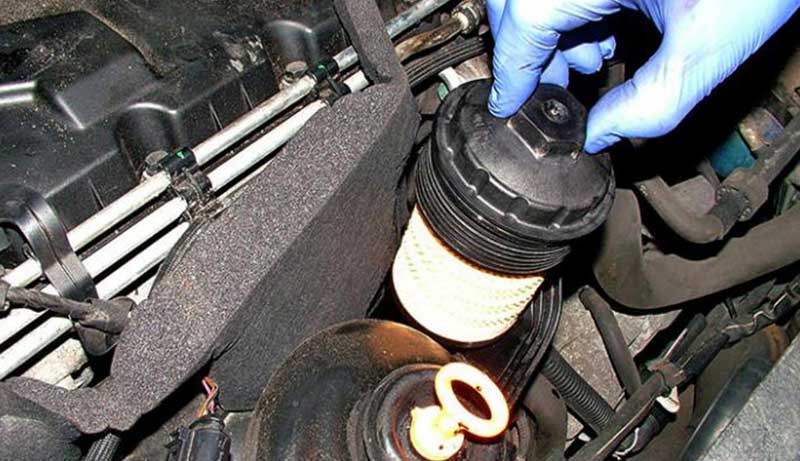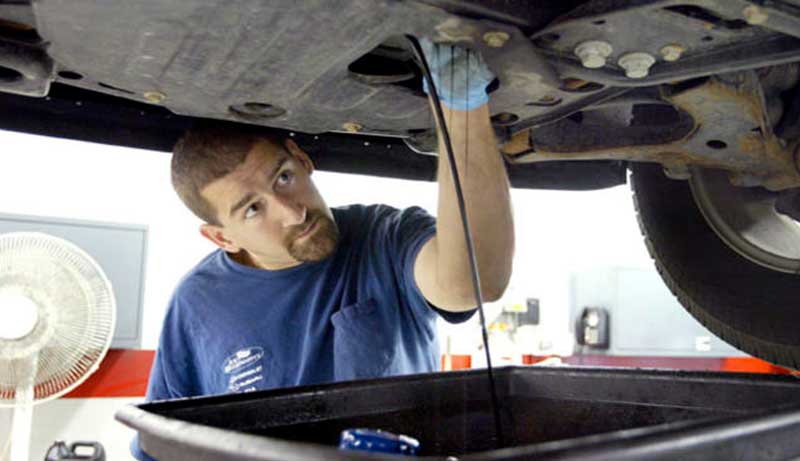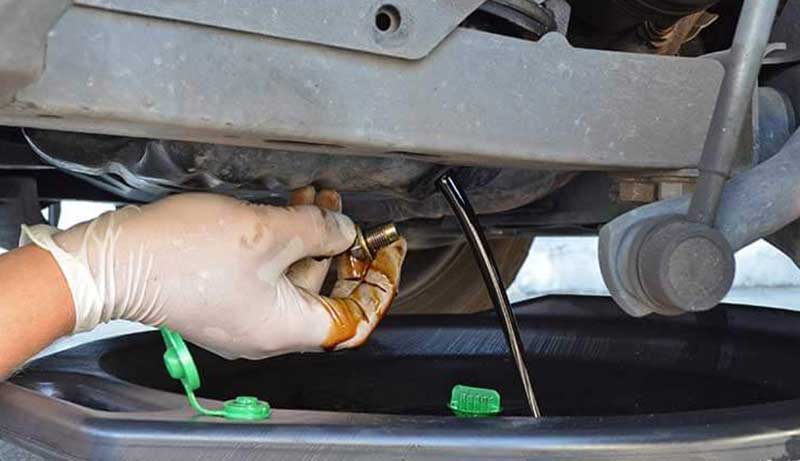One of the most common car maintenance tasks is changing the oil filter. Many people think that you have to drain the oil before you can change the filter, but that’s not the case at all. In this guide, we’ll walk you through the process of changing an oil filter without draining any oil. It’s a quick and easy process, and it can save you a lot of time and hassle. So let’s get started!
So the question arises to many Car users how to Changing Oil Filter Without Draining Oil?
The answer is Yes, you can easily change your car’s oil filter without having to drain any oil.
Here’s how:
- Park your car on a level surface and turn off the engine. Place a pan under the oil filter to catch any oil that may drip out.
- Remove the oil filter. In most cars, the filter is located on the side of the engine block. Simply unscrew it by hand or use an oil filter wrench.
- Install the new filter. Make sure that the new filter is screwed on tight by hand. You don’t want it to come loose and cause an oil leak.
- Start the engine and check for leaks. If you see any oil leaking from the filter, tighten it up a bit more.
- Check your oil level and add more if necessary. Finally, check the oil level on the dipstick and add more if necessary. You’re now ready to hit the road!
Changing your car’s oil filter is a simple and easy process that anyone can do. There’s no need to drain the oil, and it only takes a few minutes. So next time you need to change your filter, remember that you can do it without draining any oil.
Changing Oil Filter Without Draining Oil

The first thing you’ll need to do is locate the oil filter. It’s usually located on the side of the engine, near the bottom. Once you’ve found it, use a wrench or socket to remove the housing. Be careful not to over-tighten the housing, as this can cause damage to the engine.
Next, remove the old filter and replace it with a new one. Make sure that the new filter is properly seated and tightened before you replace the housing. Again, be careful not to over-tighten the housing.
Finally, check the oil level and add more if necessary. You’re now ready to hit the road!
Can you change the oil filter without emptying the oil?

The process of changing an oil filter without draining any oil is known as a dry change. This can be done by using a special wrench to remove the old filter and screw on a new one in its place. The oil will then need to be filled back up to the proper level.
There are a few things to keep in mind when performing a dry change:
- It’s important to have the right tools for the job. A regular wrench won’t do the trick. You’ll need a special wrench that’s designed for oil filters.
- Be careful not to over-tighten the new filter. Just snug it up until it’s hand-tight.
- Check your owner’s manual to see what type of oil filter is recommended for your car.
How to change oil without removing drain plug?

If you’re looking to change your oil without removing the drain plug, there are a few things you need to know. Follow this ultimate guide and you’ll be able to do it like a pro!
Firstly, you’ll need to gather all the necessary materials. This includes an oil catch basin, some rags or towels, and of course, the new oil. Make sure you have enough oil to completely fill up your engine – you don’t want to skimp on this important step!
Once you have everything ready, the next step is to locate the oil fill cap. This is usually located on the top of the engine, near the front. Once you’ve found it, unscrew the cap and set it aside.
Next, you’ll need to find the oil dipstick. This is usually located near the back of the engine, and will have a handle that you can pull out. Carefully remove the dipstick and set it aside.
Now, it’s time to start draining the old oil. Place your catch basin underneath the drain plug, which is usually located near the bottom of the engine block. Loosen the drain plug with a wrench, and allow all the old oil to drain out into the basin.
Once the oil has finished draining, replace the drain plug and tighten it securely with a wrench. Be sure not to overtighten – just snug it up until it’s tight.
Next, you’ll need to add the new oil. Pour it in slowly, until the engine is full. Once you’ve added the new oil, screw the oil fill cap back on and check the level with the dipstick. Add more oil if necessary, until the dipstick reads full.
That’s it! You’ve successfully changed your oil without removing the drain plug. This method is quick, easy, and doesn’t require any messy cleanup. Plus, it’ll save you a few bucks next time you visit the auto shop!
Can you reuse a car oil filter?

You may be wondering if you can reuse your car’s oil filter. The answer is yes, you can reuse a car oil filter, but there are some things to keep in mind before doing so.
Here are some tips on how to safely reuse your car’s oil filter:
- Make sure the filter is clean before reuse. A dirty filter can cause problems with your car’s engine.
- Inspect the filter for any damage. If you see any damaged or missing parts, do not reuse the filter.
- If the filter is reusable, follow the instructions provided by the manufacturer.
Reusing a car oil filter can save you money and help keep your car’s engine running smoothly. Just be sure to follow the tips above to ensure that you are doing it safely.
Do you have any questions about can you reuse a car oil filter? Leave us a comment below and we’ll be happy to help!
Changing the oil without removing drain plugs?

Changing your oil and filter is one of the most basic, and important, maintenance tasks for your car. Here’s a quick overview of what you need to do, how often, and why it matters.
Why Change Your Oil?

Your car’s engine oil lubricates and cools engine parts, helps keep the engine clean, and prevents corrosion. Over time, however, oil breaks down and gets dirty. That’s why it needs to be changed regularly.
How Often Should You Change Your Oil?

Most automakers have moved away from the 3,000-mile oil change interval, instead recommending intervals closer to 5,000 or 7,500 miles under normal driving conditions. However, if you drive in stop-and-go traffic, tow a trailer, or do a lot of driving in extreme weather conditions, you may need to change your oil more frequently.
How to Change Your Oil

Changing your own oil is a relatively simple process that just about anyone can do. You’ll need a few basic tools and supplies, including:
- A socket wrench and ratchet
- An oil filter wrench
- A drain pan
- New engine oil
- A new oil filter
1. Warm up the engine. This helps the oil flow more easily.
2. Locate the oil drain plug under the car and place the drain pan underneath it.
3. Use the socket wrench to remove the drain plug and let the oil drain out.
4. Replace the drain plug and tighten it.
5. Remove the old oil filter and replace it with a new one.
6. Pour new oil into the engine, being careful not to overfill it.
7. Start the engine and check for leaks.
8. Check the oil level with the dipstick and add more oil if necessary.
And that’s it! You’ve successfully changed your own oil and filter. Depending on your driving habits, you’ll need to repeat this process every few months or so.
FAQs
1. How often should I change my oil filter?
It’s generally recommended that you change your oil filter every 5,000 miles or so. However, it’s a good idea to check your owner’s manual for specific recommendations.
2. What type of oil filter should I use?
There are a variety of oil filters on the market, and it’s important to choose the right one for your vehicle. Consult your owner’s manual or a qualified mechanic to find the best filter for your car.
3. Can I change my own oil filter?
Yes, you can! However, if you’re not comfortable doing it yourself, we recommend taking your car to a qualified mechanic.
4. What happens if I don’t change my oil filter?
If you don’t change your oil filter, the oil in your engine will eventually become contaminated and can break down. This can lead to engine damage and decreased performance.
5. How much does it cost to change an oil filter?
The cost of changing an oil filter varies depending on the type of vehicle you have. However, it’s generally a fairly inexpensive procedure.
6. Do I need to drain the oil before changing the filter?
No, you don’t need to drain the oil before changing the filter. In fact, it’s often not necessary to drain the oil at all when changing the filter.
7. What tools do I need to change an oil filter?
The only tools you’ll need to change an oil filter are a wrench or socket and a new filter.
8. Can I change my oil filter without a wrench?
It’s possible to change your oil filter without a wrench, but it’s generally not recommended. If you don’t have a wrench, we recommend taking your car to a qualified mechanic.
9. How long does it take to change an oil filter?
The whole process should only take about 10 minutes or so.
10. I’m having trouble finding my oil filter. Where is it located?
The oil filter is usually located on the side of the engine, near the bottom. If you’re having trouble finding it, consult your owner’s manual or a qualified mechanic.
Final Words
Changing your own oil filter is a great way to save time and money. With this guide, you’ll be able to do it quickly and easily. So don’t hesitate to give it a try!
Also Check:



